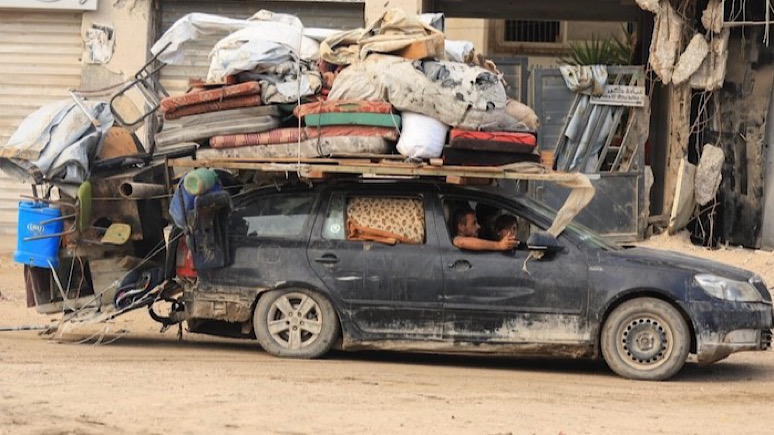


[Order Michael Finch’s new book, A Time to Stand: HERE. Prof. Jason Hill calls it “an aesthetic and political tour de force.”]
Israel is intent on emptying Gaza City of most of its inhabitants, who are used by Hamas as shields against IDF attack. One million people lived in Gaza City just two weeks ago, and it was widely predicted that it would be impossible for the IDF to persuade more than a handful to leave. But now 350,000 have left Gaza City and headed south to the “safe areas” that the IDF has delineated. Hamas has been warning them not to leave, and its operatives have fired at the legs of Gazans trying to flee. But that hasn’t stopped the flood of people trying to leave the city. And it looks like the IDF will achieve its objective of emptying out the city before the final assault on Hamas, to wipe out what remains of the terror group’s fighters in their last bastion. More on the outflow of civilians from Gaza City can be found here: “Gaza City exodus grows, undermining Hamas strategy, analyst says,” Maariv, September 15, 2025:
A growing wave of departures from Gaza City, driven by collapsing morale and fear of having nothing to return to, is eroding a core pillar of Hamas’s war strategy, Hamas economy expert Eyal Ofer told Maariv on Monday.
He said the shift is unfolding across Gaza as families weigh repeated evacuations, widespread destruction, and price shocks that make staying untenable.
Over the past two years, many Gaza City residents have traced the same route three times, Ofer said, moving from Gaza to Rafah, back to Gaza, and now again south. Unlike the early wartime flight and the relief felt by some who returned during January’s hostage deal, he said, part of the population has reached a breaking point.
As evidence, Ofer cited sharp spikes in moving costs reported on Gaza Telegram and X channels. Truck fees from the Rimal neighborhood to the south have jumped to 3,000–4,000 shekels, up from about 1,500 shekels only days earlier, he said.
Residents pointed to fuel prices to explain the surge, Ofer noted. With a liter of fuel near 100 shekels and a round trip requiring hours and about 10 liters, fuel alone can cost roughly 1,000 shekels. In the south, apartments are scarce and expensive, with some listings at 8,000 shekels a month and plots for tents reaching 1,000 shekels….
In a previous round, about 350,000 people stayed in northern Gaza. Today, Ofer estimated, roughly twice that number remain, crowded into a smaller area in western Gaza City, and the key question is how many will choose to stay at any cost. “War is first a contest of will,” he said, adding that a continued civilian outflow would further undercut Hamas’s leverage.
“On social media, many Gazans already plead: ‘Just open the Rafah crossing. From there, we will manage on our own.’”
Of course, It is Egypt, not Israel, that keeps the Rafah crossing closed. Egypt doesn’t care about the welfare of Gazans; it doesn’t want them entering the country where they would almost certainly be an economic burden, and possibly a source of support for the Muslim Brotherhood, of which Hamas is the Gazan version. The Muslim Brotherhood is the mortal enemy of the regime of General al-Sisi. It makes sense for the Egyptians to keep the Gazans bottled up in the Strip.
As the demand in Gaza City for trucks to carry whole households of mattresses, furniture, and families rises, the price for truck rentals also rises, and so does the price of diesel fuel. The cost of moving out of Gaza City becomes ever more expensive. Many are now moving out of Gaza City by donkey wagon and on foot, unable to carry very much to the designated safe zones, including Al-Mawasi, further south. As the costs of moving out of Gaza City inexorably rise, there is more pressure to leave the city before those prices rise still further. That is why the exodus out of Gaza City, slow at first, is picking up steam and will soon become a flood that Hamas, despite its disinformation campaign to scare city residents not to move, claiming that there is no “safe zone” to the south and they will be harmed by the Israelis, and despite its operatives now shooting the legs of Gazans to try to prevent them from walking south, will not be able to stop.
